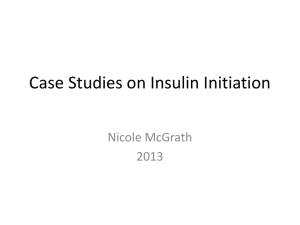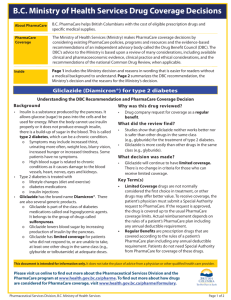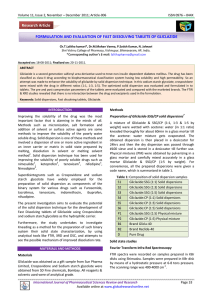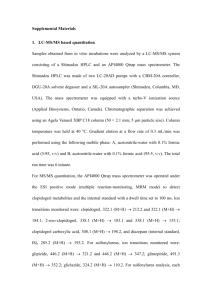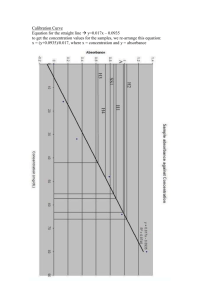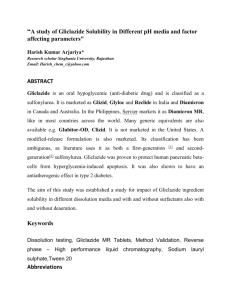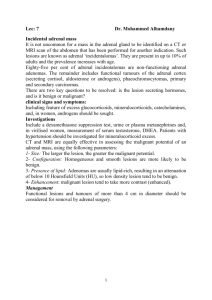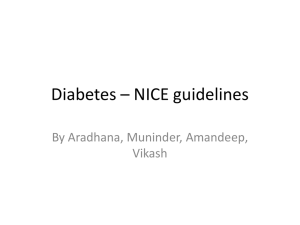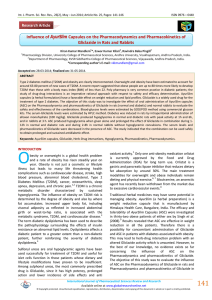Apo-Gliclazide
advertisement
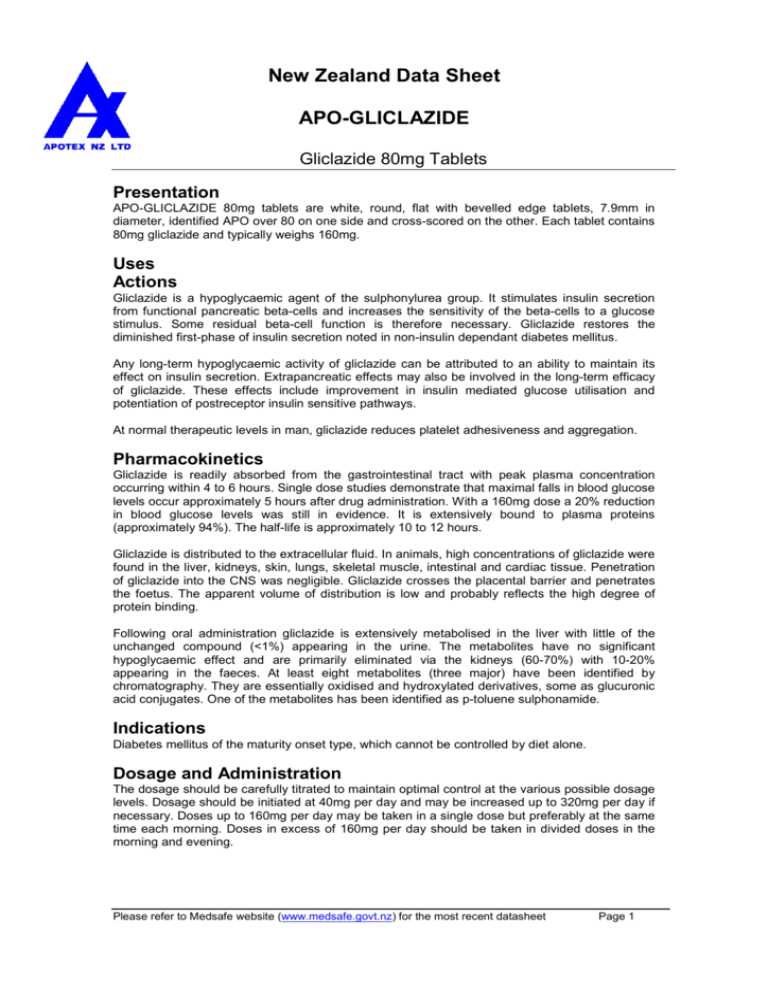
New Zealand Data Sheet APO-GLICLAZIDE Gliclazide 80mg Tablets Presentation APO-GLICLAZIDE 80mg tablets are white, round, flat with bevelled edge tablets, 7.9mm in diameter, identified APO over 80 on one side and cross-scored on the other. Each tablet contains 80mg gliclazide and typically weighs 160mg. Uses Actions Gliclazide is a hypoglycaemic agent of the sulphonylurea group. It stimulates insulin secretion from functional pancreatic beta-cells and increases the sensitivity of the beta-cells to a glucose stimulus. Some residual beta-cell function is therefore necessary. Gliclazide restores the diminished first-phase of insulin secretion noted in non-insulin dependant diabetes mellitus. Any long-term hypoglycaemic activity of gliclazide can be attributed to an ability to maintain its effect on insulin secretion. Extrapancreatic effects may also be involved in the long-term efficacy of gliclazide. These effects include improvement in insulin mediated glucose utilisation and potentiation of postreceptor insulin sensitive pathways. At normal therapeutic levels in man, gliclazide reduces platelet adhesiveness and aggregation. Pharmacokinetics Gliclazide is readily absorbed from the gastrointestinal tract with peak plasma concentration occurring within 4 to 6 hours. Single dose studies demonstrate that maximal falls in blood glucose levels occur approximately 5 hours after drug administration. With a 160mg dose a 20% reduction in blood glucose levels was still in evidence. It is extensively bound to plasma proteins (approximately 94%). The half-life is approximately 10 to 12 hours. Gliclazide is distributed to the extracellular fluid. In animals, high concentrations of gliclazide were found in the liver, kidneys, skin, lungs, skeletal muscle, intestinal and cardiac tissue. Penetration of gliclazide into the CNS was negligible. Gliclazide crosses the placental barrier and penetrates the foetus. The apparent volume of distribution is low and probably reflects the high degree of protein binding. Following oral administration gliclazide is extensively metabolised in the liver with little of the unchanged compound (<1%) appearing in the urine. The metabolites have no significant hypoglycaemic effect and are primarily eliminated via the kidneys (60-70%) with 10-20% appearing in the faeces. At least eight metabolites (three major) have been identified by chromatography. They are essentially oxidised and hydroxylated derivatives, some as glucuronic acid conjugates. One of the metabolites has been identified as p-toluene sulphonamide. Indications Diabetes mellitus of the maturity onset type, which cannot be controlled by diet alone. Dosage and Administration The dosage should be carefully titrated to maintain optimal control at the various possible dosage levels. Dosage should be initiated at 40mg per day and may be increased up to 320mg per day if necessary. Doses up to 160mg per day may be taken in a single dose but preferably at the same time each morning. Doses in excess of 160mg per day should be taken in divided doses in the morning and evening. Please refer to Medsafe website (www.medsafe.govt.nz) for the most recent datasheet Page 1 APO-GLICLAZIDE Gliclazide 80mg Tablets The dosage will depend upon the severity of the glycaemia with ongoing adjustments made in order to obtain optimal response at the lowest dosage. Treatment with gliclazide does not obviate the need to maintain standard dietary requirements. Contraindications Diabetes complicated by acidosis, ketosis or coma or in patients with a history of repeated episodes of ketoacidosis or coma. Juvenile onset diabetes and unstable or brittle diabetes. Severe renal and liver insufficiency. Known hypersensitivity to sulphonylureas Warnings and Precautions Acute complications such as severe trauma, fever, infection or surgery These acute complications provoke additional metabolic stress which may increase the predisposition to hyperglycaemia and ketosis. Patients with such conditions may require insulin to maintain control. It is not appropriate to increase the dosage of gliclazide. Hypoglycaemia Close observation and careful initiation and adjustment of dosage is mandatory in patients who are elderly, debilitated, malnourished, semi-starved or simply neglect dietary restrictions. Severe hypoglycaemia may occur in such patients requiring corrective therapy over a period of several days. Alcoholism, insulinoma, adrenal thyroid and pituitary insufficiency increase the sensitivity to sulphonylureas and may dispose towards hypoglycaemia. Monitoring Patients must be under close supervision. Particular care must be taken during the initial period of stabilisation. Patients should be monitored regularly to ensure optimal control of the diabetic state and where necessary for adjustment of dosage. Transferring to Gliclazide Patients who have been previously treated with sulphonylureas or biguanides alone or in combination may be transferred to gliclazide. When gliclazide is administered as sole therapy to patients who have previously been receiving combination therapy careful observation is required during the transitional phase. It is not generally recommended that insulin treated patients been transferred to gliclazide. Comprehensive instructions must be given to the patients about the nature of the disease and what must be done to detect and prevent complications. Use in Pregnancy and Lactation Category C. It is important to achieve strict normoglycaemia during pregnancy. Oral hypoglycaemic agents should be replaced by insulin. Please refer to Medsafe website (www.medsafe.govt.nz) for the most recent datasheet Page 2 APO-GLICLAZIDE Gliclazide 80mg Tablets Sulphonylureas may enter the foetal circulation and cause neonatal hypoglycaemia. In animal studies embryotoxicity and/or birth defects have been demonstrated. Gliclazide should not be used by pregnant women. While animal studies have not shown any teratogenic effect gliclazide should only be used in women likely to become pregnant if the benefits outweigh the potential risk. Some sulphonylureas are excreted in human breast milk. Because of the potential for hypoglycaemia in nursing infants to exist, a decision should be made to either discontinue breastfeeding or to discontinue the medication taking into account the importance of the medication to the mother. Children Safety and effectiveness in children have not been established. Adverse Effects In clinical trials the incidence rate of adverse reactions was 10.5% necessitating discontinuation of therapy in 1.2% of patients. Hypoglycaemia Manifestations of hypoglycaemia including dizziness, lack of energy, drowsiness, headache and sweating have been observed. Weakness, nervousness, shakiness and paraethesia have also been reported. Severe hypoglycaemia which mimics acute CNS disorders may occur. Hepatic and /or renal disease, malnutrition, debility, advanced age, alcoholism, adrenal or pituitary insufficiency may be predisposing factors. Gastrointestinal Nausea, vomiting, diarrhoea, epigastric fullness and gastric irritation can be observed. These reactions are usually dose related and may disappear when the dose is reduced. Heptobiliary Rare cases of jaundice have been reported. Dermatological Allergic reactions e.g. pruritus, erythema, urticaria and morbiliform or maculopapular rash have been reported. These reactions may persist during treatment which must then be interrupted. Cases of porphyria cutanea tarda and of photosensitivity have also been reported with sulphonylurea drugs. Haematological Rare cases of leucopenia, agranulocytosis, thrombocytopenia and anaemia have been reported. Metabolic Cases of hepatic porphyria and disulfram-like reactions have been reported with sulphonylurea drugs. Clinical experience to date shows that gliclazide has a low incidence of disulfram type reactions. Endocrine A decrease in the uptake of radioactive iodine by the thyroid gland has been reported with other sulphonylurea drugs. This has not been reported with gliclazide. Please refer to Medsafe website (www.medsafe.govt.nz) for the most recent datasheet Page 3 APO-GLICLAZIDE Gliclazide 80mg Tablets Laboratory Tests The pattern of laboratory tests abnormalities observed with gliclazide was similar to that for other sulphonylureas. Occasional mild to moderate elevations of AST, alkaline phosphatase, BUN, serum bilirubin and creatinine and decrease in natremia have been observed. Interactions Hypoglycaemia may be potentiated when gliclazide is used concurrently with other medication including insulin, biguanides, long-acting sulphonamides, tuberculostatics, oxyphenbutazone, phenylbutazone, clofibrate, MAO inhibitors, coumarin derivatives, salicylates, probenecid, chloramphenicol, propranolol, miconazole, cimetidine, disopyramide, beta-blockers and ACE inhibitors. Certain medications tend to induce hyperglycaemia and may lead to loss of control of blood sugar control. These include thiazide diuretics, corticosteriods, oestrogens and nicotinic acid in pharmacological doses. Barbiturates should be used with caution as they may reduce the hypoglycaemic effect of gliclazide. Intolerance to alcohol (disulfram-like reaction: flushing, sensation of warmth, giddiness, nausea and occasionally tachycardia) may occur. Chronic alcohol abuse may as a result of liver-enzyme induction stimulate the metabolism of sulphonylurea drugs and shorten plasma half-life and duration of action. Overdosage Symptoms Overdosage may result in hypoglycaemia but it should be noted that the dosage which causes such hypoglycaemia varies widely and may be within the accepted therapeutic range in sensitive individuals. Manifestations of hypoglycaemia include sweating, flushing or pallor, numbness, chilliness, hunger, trembling, headache, dizziness, increased pulse rate, palpitations, increased blood pressure and apprehensiveness in mild cases. In more severe cases coma occurs. However symptoms of hypoglycaemia are not necessarily as typical as those above and sulphonylureas may cause insidious development of symptoms mimicking cerebrovascular insufficiency. Treatment Restore consciousness by the administration of intravenous glucose or glucagon injection, care being taken to ensure against the return of hypoglycaemia by constant monitoring of the blood sugar level. Pharmaceutical Precautions Store below 25°C. Protect from heat, light and moisture. Medicine Classification Prescription Only Medicine Package Quantities Bottle packs containing 100 and 500 tablets. Blister packs containing 30 and 90 tablets. Please refer to Medsafe website (www.medsafe.govt.nz) for the most recent datasheet Page 4 APO-GLICLAZIDE Gliclazide 80mg Tablets Further Information Tablets contain lactose. Name and Address Apotex NZ Ltd. 32 Hillside Road Glenfield Private Bag 102-995 North Shore Mail Centre Auckland Telephone: (09) 444-2073 Date of Preparation 31 May 2002 Please refer to Medsafe website (www.medsafe.govt.nz) for the most recent datasheet Page 5
